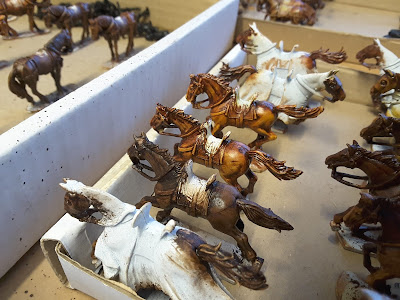domingo, septiembre 13, 2020
How To Paint Horses Using The Oil Paint Wipe Method
If you exclude "what are you doing in my back garden dressed as a chicken ?" one of the most common questions I get is how do you paint you horses. The other, how do you do your sea bases will be the subject of the Yarkshire TV treatment soon, however for now here is a video run through of painting horses in oils.
It's quite lengthy (45 mins plus) but I have covered everything, equipment, paints, techniques, figures etc so if you are interested in trying out the oil method give this video a go.
You can get through horses at a fair rate of knots too, any questions just ask.
Questions Answered
On the various formats this video has been posted on there have been a few common questions so to save me posting the same thing on different formats here they are,
How long is the drying time post wipe ?
The drying time post wipe is obviously variable around how much oil you use, room temperature etc but is considerably less than an unwiped figure.
I leave mine a minimum of a week before I start using acrylics for reins, saddle, white markings etc. I would give it a couple of days minimum in a warm room.
The problem area will often be the recesses around the harness as this is where the deepest amount of oil paint sits. If your unsure try a test patch.
It's never a problem for me, the big selling point of this method is speed of painting so I paint in batches of 50 to 100 horses so they sit around sometimes for over a year to be painted.
What are the best colour combinations ?
The first thing I would say on this is that another of the strong points of this method for me is the hundreds of different combinations of colours and the subtle effects you can achieve, even using the same oil colour but with a different consistency will give a different effect so it's very hard to quantify. My top tip is to find stuff out by trial and error.
Golden Rule number one is that the oil paint must be darker than the acrylic base otherwise their will be no contrast
If you want a colour combination to try as a test I would use a Vallejo 70856 Ochre Brown base with a Brown Madder (or Burnt Umber) oil layer.
The darkest oil paint is Vandyke Brown which is almost black. This works best with the dark base coats so try 70814 Burnt Cadmium Red as a base. Others to try are darker browns like 312 (Panzer Aces) Leather Belt, 70983 Flat Earth, 70921 English Uniform, 70879 Green Brown.
Going lighter next up would be Burnt Umber, this is a very dark but slightly redder colour than Vandyke Brown. It works best with dark ochre type colours so Ochre Brown, 70914 Green Ochre 70825 German Pale Brown are good.
In between Burnt Umber and the next colour is Raw Umber, this is a very earthy brown and doesn't have the sheen of other colours, I use it sparingly over German Pale Brown and 70874 USA Tan Earth.
Next lighter are Brown Madder and Brown Transparent Oxide, I have put these two together as they are very similar but give a subtle difference in effect, the transparent oxide being, well more transparent. These are the most versatile colours and work well with the Burnt Umber colours. Go to is Ochre Brown as mentioned above. Also good are 70977 Desert Yellow, 70912 Tan Yellow, 70913 Yellow Ochre.
Finally the lightest Oils Burnt Sienna and Brown Ochre, these only work with quite lighter colours and I sometimes mix a bit of Burnt Umber in to darken them up. Go with Desert Yellow, Tan Yellow, 70847 Dark Sand, Yellow Ochre, 70976 Buff.
Hope that sends you in the right direction. I encourage experimenting with the colours, try some of the light bases like Dark Sand with Brown Madder for example and see if you like it. So long as the oil paint is darker than than the base it will work, you will find the best combinations for your taste.
What consistency of oil paint should I use ?
Paint straight from the tube is too thick, get some distilled turpentine like in the video, put a small amount of oil paint on a none absorbent surface (size of your little finger nail) add a touch of turps to the brush, pick up some oil paint on the brush and mix them together on the surface.
You are looking for a consistency off oil, thin enough to flow easily over the horse and get into all the recesses but thick enough to give a full colour coverage.
Suscribirse a:
Enviar comentarios (Atom)


No hay comentarios:
Publicar un comentario